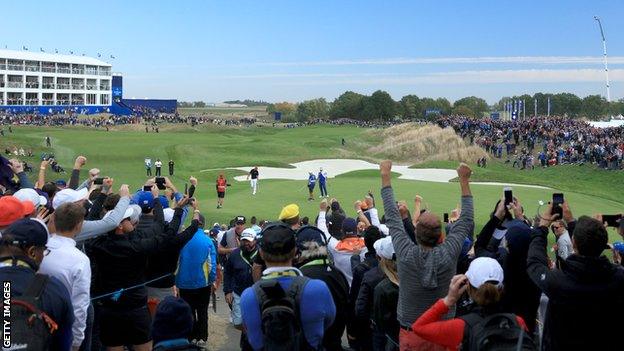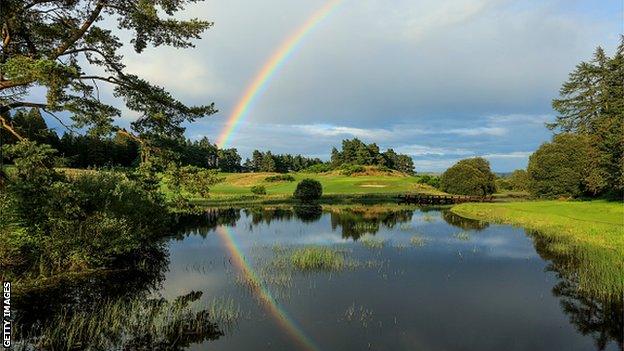Curse of the Ryder Cup? The iconic venues overlooked on the golfing calendar
- Published

Le Golf National was a popular venue for the 2018 Ryder Cup
They stage the biggest golf events in Europe, but what is the long-term legacy for the courses that hold the Ryder Cup? Why do they disappear from relevance soon after being centre of the golfing world?
These are questions worth considering in the week that Le Golf National plays host to the French Open for the first time since the continent's thumping victory over the United States just over a year ago.
One thing is for sure, this autumnal running of the oldest national Open in continental Europe will not be as grand as the French Opens that preceded the 2018 Ryder Cup.
The tournament has been shifted from a prime position in the schedule at the end of June and is now worth only £1.4m compared with the £5.6m purse that was played for last year.
Make no mistake, there will still be significant golf on show. The scramble to keep cards and qualify for the Race to Dubai finale is intensifying.
And the likes of Martin Kaymer, Jose Maria Olazabal, Thomas Bjorn and Jamie Donaldson add some stardust.
But when Alex Noren won 15 months ago he beat a field that included defending champion Tommy Fleetwood, Spanish giants Jon Rahm and Sergio Garcia, US star Justin Thomas and Ryder Cup stalwart Ian Poulter.
This week Bjorn returns to the scene of his team's tumultuous victory as one of the main playing attractions rather than chief strategist for an extraordinary European triumph.
That 17½-10½ win generated lifelong memories and scenes to inspire future generations. The course - set up perfectly to suit the home team - and the prime location near Paris played huge parts in creating an iconic week for European golf.
But it feels as though Le Golf National may follow so many venues that staged home matches for Europe into relative obscurity. Courses that were once staples on the circuit have faded from significance.

Gleneagles is no longer part of the European Tour
The Belfry hosted the Ryder Cup on four occasions between 1985 and 2002 and whatever you think of the course, which does have its critics, the layout in the English midlands became a big part of the fabric of European golfing history.
But the Brabazon Course has not staged a Tour event since the 2008 British Masters., external Celtic Manor in south Wales disappeared from the schedule in 2014, four years after its Ryder Cup., external
The K Club, which hosted the 2006 match in County Kildare, was the continuous home of the European Open between 1995 and 2007. It then disappeared from the calendar other than in 2016 when it held the Irish Open.
Gleneagles staged the 2018 European Team Championships and this year's Solheim Cup but its deal to hold tour events expired the year before putting on the 2014 Ryder Cup.
Only Valderrama (1997 Ryder Cup) in southern Spain has remained a regular stop for the continent's leading players in the wake of holding one of the biennial jousts between Europe and the US.
So the portents are not good for Le Golf National, especially at a time when the value of the French Open has somewhat diminished.
Initially the French Federation signed a 12-year deal that would have taken them through to 2022 with the tournament being guaranteed to be worth a minimum of 3m euros.
This crashed with the loss of prime sponsor Alstom, but for 2016 the European Tour landed a more lucrative deal with Chinese conglomerate HNA. The five-year agreement worth 25m euros seemed to secure the event's top-level status.
But that deal fell through leaving this historic tournament no longer able to justify a place in the tour's elite Rolex Series. So now it sits in this October date, somewhat detached from the limelight it once commanded.
"The change of date is acceptable, the biggest tournaments should have the best dates," Pascal Grizot, president of France's 2018 Ryder Cup committee, admitted to L'Equipe last year.
But the official questioned why the European Tour did not do more to support the tournament. "Why didn't they decide to help the French Open and the federation as we were extremely loyal for the Ryder Cup?" he asked.
The simple answer comes down to money, like with so many other former Ryder Cup venues. There is cash generated to put these places on the map but it disappears once the objective of staging golf's biggest event has been satisfied.
It could prove a similar story for Le Golf National. According to next year's schedule the French Open will move back to high summer, but there is no word on which course will stage the tournament nor the size of its purse.
Places that instantly resonate with golf fans everywhere; The Belfry, K Club, Celtic Manor, Gleneagles and now potentially Le Golf National are not just venues that have carved big places in the game's folklore.
They also provide proof that business reality leaves little room for preserving and nurturing that golfing history.
